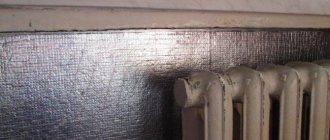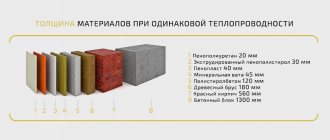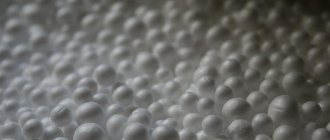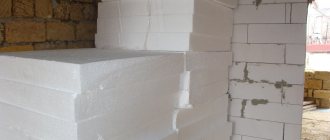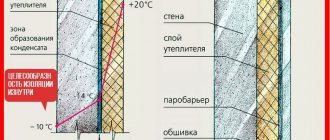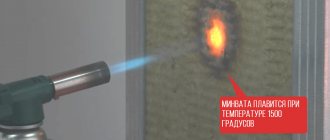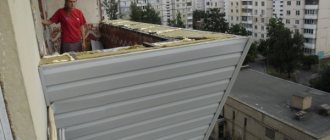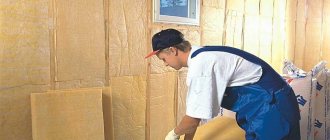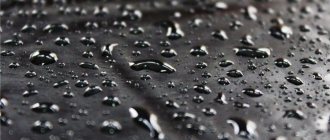What is the dew point for walls?
The air in the environment always includes water vapor, the concentration of which depends on many factors. Inside buildings, steam is emitted by people and other living organisms. It also enters the internal space from various everyday processes - washing, ironing, cleaning, cooking, and so on.
Outside, the percentage of moisture in the atmosphere depends on weather conditions. Moreover, the filling of air with vapor has its own limit, upon reaching which the process of moisture condensation and the formation of fog follows.
At this moment, the air mixture absorbs the maximum amount of steam and its relative humidity is 100%. Subsequent saturation leads to the appearance of fog - small droplets of water in the atmosphere.
When an air mass that is not completely saturated with vapor (humidity less than 100%) comes into contact with a surface whose temperature is several degrees lower than its own, condensation forms even without fog.
The fact is that air at different temperatures can hold different amounts of steam. The higher the temperature, the more moisture it can absorb. Therefore, when an air mixture with a relative humidity of 80% comes into contact with a cooler object, it cools sharply, its saturation limit decreases, and the relative humidity reaches 100%.
Then condensation occurs, that is, a dew point appears. This is exactly the phenomenon that can be observed on the grass in the early summer morning. At dawn, the soil and grass are still cold, and the sun quickly heats the air, its humidity near the ground quickly reaches 100% and dew falls. The condensation process is associated with the release of thermal energy that was previously spent on vaporization. Therefore, the dew disappears quickly.
Thus, the dew point temperature is a variable value that depends on the relative humidity and air temperature at a certain moment. To determine the dew point and its temperature, various meters are used - thermohygrometers, psychrometers and thermal imagers.
The dew point depends on the relative humidity of the air. The higher it is, the closer the TP is to the actual air temperature. If the relative humidity is 100%, then the dew point is the same as the actual temperature.
The dew point in construction is necessary in order to understand whether the degree of wall insulation is adequate to prevent condensation from forming.
At dew point values of more than 20 °C, physical discomfort is felt, the air seems stuffy; above 25 °C people with heart or respiratory diseases are at risk. But such values are achieved very rarely even in tropical countries.
How to calculate dew point
To calculate the dew point, a table of water vapor condensation values is used depending on humidity and temperature. The value of external and internal temperature and the value of external and internal humidity are taken. The dew point temperature at which water will drop out of water vapor (dew formation) is obtained.
Dew Point TABLE:
What does this temperature give us? A lot of things. We are able to calculate where the vapor will condense in the insulation cake, that is, where the dew point will be in the wall - in the insulation, in the load-bearing wall or on the inner surface of the load-bearing wall - right in the room.
Naturally, the most correct option is the dew point in the insulation. In this case, there will be no negative aspects for the interior. To avoid any negative aspects for the insulation, it is worth choosing the right type of insulation for the walls at the planning stage.
A less acceptable option is the dew point in the wall of the house, which is load-bearing. Here, the negative aspects for the interior will depend on the wall material. This situation occurs when the insulation is installed incorrectly or the thickness of the insulation is incorrectly selected.
Here you can clearly see how the dew point in the wall of the house will shift.
The most unacceptable option is the dew point inside the room, on the inner surface of the load-bearing wall. This usually happens when the house is not insulated at all or is insulated incorrectly - from the inside.
How to determine the dew point?
In fact, to determine the dew point you do not need to make complex technical calculations using formulas, measure relative air humidity, etc. There is no point in thinking about how to calculate the dew point, since specialists have already done this a long time ago. And the results of their calculations are listed in a table that shows the surface temperatures below which condensation begins to form from air with different humidity levels.
The purple color indicates the temperature according to the snip in the room in winter - 20 ° C, and the green sector indicates the range of normalized humidity - from 50 to 60%. In this case, TP ranges from 9.3 to 12 °C. That is, if all standards are observed, condensation will not form inside the house, since there are no surfaces in the room with such a temperature.
The situation is different with the outer wall. From the inside it is enveloped by air heated to +20 °C, and from the outside it is exposed to -20 °C or more. Accordingly, in the thickness of the wall the temperature slowly increases from -20 °C to + 20 °C and in a certain zone it will definitely be equal to 12 °C, which will result in condensation at a humidity of 60%.
But for this it is still necessary that water vapor reaches this zone through the material of the supporting structure. Here another factor appears that affects the determination of the dew point - the vapor permeability of the material. This parameter should always be taken into account when constructing walls.
So, the process of condensation formation inside external walls is influenced by the following factors:
- ambient temperature;
- relative humidity;
- temperature in the thickness of the wall;
- vapor permeability of the material of the constructed walls.
There are no analyzing devices to measure these indicators in the thickness of the wall. They can only be calculated by calculation.
How to calculate dew point
To determine the dew point in a frame house, several alternative methods are used:
- table method;
- calculation method;
- use of an electronic thermohygrometer.
The most accessible is the tabular method, which is based on the application of Appendix “P” to SP 23-101-2004 “Value of dew point temperature for various temperature indicators and relative humidity in the room.” Here it is enough to select the required temperature and humidity level in the room and see the desired dew point temperature at the intersection of the row and column. For example, at room temperature +240C and normal humidity 65%, the dew point temperature will be +170C. A hygrometer with a psychrometric table will allow you to take real temperature and humidity readings and more accurately calculate the dew point from the table.
The calculation method uses special formulas. The simplest one has the form Tr≈T - (1-Rh)/0.05, where:
- TR – dew point temperature;
- T – room air temperature;
- Rh – humidity in volume fractions.
Using the same data, you can verify the correctness of the table indicators: Tr≈ 24- (1-0.65)/0.05=17.
The electronic thermo-hygrometer independently calculates the temperature and humidity of the surrounding air and displays a ready-made calculation of the dew point parameter on the screen.
Condensation on entrance doors
The first reason for the formation of condensation on the front door is based on increased air humidity, when the indicator exceeds 55%. Then the condensate is collected on the surface, where the temperature is slightly below the “dew point”. In winter, such a surface is the front door.
It is important to maintain indoor air humidity of about 45% for the health of residents. The humidity of the internal climate is affected by both ventilation devices and the temperature of the heated air in the room. The second reason for condensation is hidden in low thermal insulation - a metal door is more prone to large amounts of condensation due to poor sealing between the metal sheet and the frame. In a typical version, there is not enough air outflow for those purposes to allow vapors to escape, but it is quite enough to deposit them on the surface.
Ways to eliminate condensation on entrance doors
The way to get rid of condensation is to ensure the influx of dry fresh air from outside and the outflow of vapors from the enclosed space. It is possible to install a “warm curtain”, which will heat the door with heated air. The surface temperature of the door leaf will increase and the dew point will shift. Insulating the door leaf will not eradicate condensation problems. Condensing moisture settles due to the large temperature difference between the outside and the room. In this case, it is recommended to install an unheated vestibule at the entrance. It would not be amiss to equip a canopy over the entrance to protect the door from direct exposure to the sun's rays and precipitation. It is recommended to open the metal sheet of the front door with special powder polymers. It is better to fill all hollow elements in a metal door with foam in order to eliminate the appearance of cold bridges.
Condensation on windows
Very often, manufacturers of modern windows have to accept complaints that their customers' windows are fogging up. The formation of condensation on windows is not only aesthetically unsightly, but also threatens the wooden structures with waterlogging and, as a result, the formation of mold. Let's look at the possible causes of condensation on windows.
Condensation is a liquid that has passed the dew point and fallen in the form of droplets on the window.
Well, if this happened on windows, then only the windows and their manufacturers are to blame. Logically this is correct, but if there is no water in the window itself and it cannot release it, where does the condensation come from?
Damage to dew point for house walls
We figured out that the dew point can be located in three different parts of the wall:
- in external wall insulation
- in the wall, closer to the outside
- in the wall, closer to the inside
In each of the listed places, the dew point will manifest itself differently. If in one place it is harmless, then inside the house or in the wall it will have certain destructive consequences on the integrity of the wall. Below, we will analyze the behavior of the dew point in each of the listed places.
Dew point in external insulation
This is the most harmless dew point for your home. In this case:
- When the dew point occurs, condensation forms directly in the insulation itself.
- The insulation is not hygroscopic, therefore moisture is not retained in the wall structure and evaporates when the air temperature changes.
- Due to the vapor barrier properties of the insulation, the moisture that is formed when condensation evaporates goes outside and does not interact with the wall of the house.
- The walls of the house are dry throughout the year, both from the outside and from the inside
- The walls retain their strength and integrity for many decades
What is dew point and why determine it?
Dew - condensation - is formed as a result of steam combining with cold air. The dew point is the temperature at which moisture begins to settle on the walls of the house. Thus provoking the formation of frozen sections of walls in winter and covered with mold in the off-season. A careful calculation of the ventilation system of a frame house and the thickness of the insulation used will help eliminate this destructive disadvantage for wood in particular and comfort in general.
The level at which the dew point is depends on the following factors:
- Room temperature. An atmosphere that is too stuffy or, conversely, cold will cause condensation to begin to form in the insulating boards, causing caking and unusability of the material. If the insulation is resistant to moisture, moisture will accumulate on wooden walls - studs, sheathing - causing rot and destruction.
- Outdoor climate. Incorrectly chosen thin insulation for the northern regions of the country or, conversely, too thick material for the southern regions will cause a similar situation.
- Humidity – internal and external.
- Reliability of the protective layers of a frame house - hydro-wind, heat and vapor barriers.
By independently selecting the above materials, the home-grown builder may not be aware of the importance of maintaining a balance with each. The consequences will not be long in coming.
The influence of material vapor permeability on the position of the dew point
When developing a construction project, attention is paid to the ability of insulating materials to allow air to pass through. The value of vapor permeability depends on how much water vapor can pass through the pores of a material in a given unit of time. Many common building materials used for the construction of walls and ceilings (brick, concrete, wood, etc.) have pores inside that allow air to pass through. Therefore, designers choose materials taking into account certain principles:
- the material must have good vapor permeability to allow free release of moisture if it has formed inside the wall structure in the form of condensation;
- the ability to transmit moisture vapor increases from the inner surface to the outer;
- The thermal conductivity of the insulation on the inner surface is assumed to be optimal and decreases towards the outer layer.
All modern buildings are built and insulated according to these principles. The exception is types of insulation that absolutely do not allow moisture and air to pass through. These include polystyrene foam, expanded polystyrene, foam aerated concrete and others. Therefore, when developing a project, the thickness of the insulation layer is calculated in such a way that condensation forms inside the insulation. The location of the dew point plays a primary role when insulating walls and floors of buildings. It must be fixed in the thickness of the structure so that it does not move towards the inner surface.
Factors affecting dew point
The above examples clearly show that there are two key factors that determine the correct position of the dew point and the operation of the wall structure. The first of these is an accurate thermotechnical calculation of the thickness of the insulation. It is performed at the project development stage and takes into account several parameters, including:
- climatic properties of the region where construction is planned;
- dimensions of the building, for example, area and number of storeys;
- number of residents;
- characteristics of the thermal insulation material used, etc.
For most of the country's territory, when using modern insulation materials, a sufficient material thickness is usually 100-150 mm. If the value of this parameter deviates in any direction, the likelihood of a situation from the first or second example described earlier is high.
The second factor influencing the effective operation of a frame wall is the correct placement of vapor and waterproofing in relation to the insulation. A ventilation gap is created on the inside and a vapor barrier film is installed, and a windproof film is installed on the outside. In this case, the condensation formed at the dew point is removed from the insulation without problems or negative consequences.
If you don't take into account the dew point
In construction , neglect of the rules and regulations when constructing structures can lead to undesirable consequences; the service life of metal, brick, concrete, wood and other materials is reduced. The formation of condensation on the area of dense polymer materials when installed as insulation is unacceptable; this will lead to the following problems:
- the surface of the material swells;
- peeling of large areas of finishing materials is observed;
- on surfaces with temperatures below the dew point, condensation necessarily occurs;
- harmful fungus and mold develop on the walls, leading to human illness;
- load-bearing structures fail earlier, which leads to premature destruction.
Possibility of insulation from the inside
It becomes clear that identical options for insulating different buildings; some developers practice installing the layer inside the room. This is the worst option, but in some individual cases such insulation can be considered justified if:
- the premises in the house belong to the place of permanent residence;
- ventilation does the job of cleaning and is designed in accordance with sanitary and technical rules;
- heating complies with standards and works without interruption;
- other structural elements of the structure are insulated in accordance with the requirements of SNiP;
- the insulated wall is of sufficient thickness and does not conduct heat well from the room to the outside, while a discrepancy in heat transfer resistance by a third of the norm is allowed.
Taking into account dew point in developed projects
The presented standard projects take into account the climatic features of the region. The correct use of all materials in strict accordance with the project guarantees not only warmth in the house, but also a long service life. In this regard, savings in the form of changes in the size of structural elements or the exclusion of part of them are unacceptable - even a minor correction of the project can nullify the entire engineering plan. On the Internet you can find online calculators for preliminary calculation of the location of the dew point, but these calculations are approximate, and none of the calculators will give guarantees in case the wall “pie” is formed incorrectly.
About the dew point in plastic windows
When it comes to the dew point in double-glazed windows, many people imagine some specific mysterious place. In reality, the dew point cannot be seen, as we have already found out. Let us repeat: dew point refers to the temperature at which, when cooled, the vapor in the air becomes saturated and condenses. There are special tables that allow you to calculate the dew point at relative humidity and a specific temperature. One such table is shown below.
Dew point at relative humidity
On a note! Let’s say the air humidity is 50% and the temperature is +21 degrees. Under such circumstances, the dew point will be +10.2. What does it mean? If the temperature of any surface in the apartment drops to +10.2 degrees, then condensation will begin to appear on it (the surface). As a rule, the coldest surfaces in the apartment are plastic windows, and therefore it is on them that in most cases excess moisture falls.
People often experience condensation on double-glazed windows. Based on everything said above, we can conclude that condensation can be dealt with in two ways - by increasing the temperature of the glass and reducing the humidity in the apartment. Thus, comfortable humidity can be achieved by ensuring normal air exchange. All excess moisture comes from washing, boiling pots, etc. – should leave the room and not accumulate in it. First of all, the apartment should be regularly ventilated. The frequency of ventilation is determined individually, but we recommend doing this for at least 10 minutes twice a day. Don’t forget about special supply ventilation valves.
Dew point
Dew point is measured in degrees. This is the temperature at which the content of water vapor in the air is maximum. The dew point cannot be more important than the air temperature - condensation occurs. For example, in a kitchen where dishes are washed and cooked, the dew point will be the temperature of the window glass on which drops of water can be seen.
The dew point can be located both outside the wall and inside, it depends on the humidity and air temperature inside and outside the room, and on the thickness and vapor permeability of each layer of the wall “pie”.
Complex finishing and insulation of walls using the “Wet Facade” technology has undeniable advantages. But the first two options are slightly different from the marketing presentations below. This is not entirely true.
Where should the dew point be?
The insulation of a fence is considered “normal” only when the dew point in cold weather is mainly (!) located in the insulation and does not move into the wall.
What does "mostly" mean? At maximum negative temperatures, which usually last for several days, a week, and occur periodically, the dew point can shift into the wall.
For a wall made of dense, heavy materials, there is nothing dangerous about this. But for walls made of porous materials, which, as usual, transmit steam very well and absorb moisture, the appearance of the dew point should be short, especially when they are combined with vapor barrier insulation.
Such walls require the most insulation, especially considering that they themselves are warm. To shift the dew point you will need 2 times more insulation. They combine much better with vapor-transparent insulation, since moisture can be removed here, but only if the insulation has excellent ventilation.
Visual temperature graphs for various insulation schemes are provided. The dew point is approximately indicated as 16 degrees, achieved when the inside of the house is particularly comfortable at +25 degrees, 55 - 60% humidity.
- 1 - wall without insulation;
- 2 - insufficient insulation layer - the dew point is inside the wall. Its constant presence will cause a leaky wall to become wet, an unhealthy atmosphere, and the danger of destruction of the material if the wall insulation layer has greater resistance to the movement of steam than the wall itself (improper insulation);
- 3 - sufficient insulation, dew point in the insulation (most of the time), normal preservation of wall materials and heat in the house, if the thermal resistance of the structure is not less than the standard one, because for very cold walls it is possible to shift the dew point from them with a small layer of insulation;
- 4 - internal insulation is the worst solution. The dew point on the surface of the wall or close to it leads to the wall getting wet, and damage to the health of residents, wet freezing and destruction of structures. It is used in desperate situations, provided that the wall is completely covered with a vapor barrier insulation, which prevents the penetration of steam to the dew point. Those. condensation is impossible due to humidity close to 0.
The standards indicate the thermal resistance of enclosing surfaces for specific climatic zones. The state forbids us to reduce this value.
More often, the standard requires a thinner insulation thickness than what is needed to shift the dew point into the insulation. Therefore, it is, in principle, desirable to select insulation for all surfaces and according to the condition of shifting the dew point into the insulation.
These values are compared with the regulatory requirement, and, as a rule, an even greater value is accepted, a multiple of the thickness of the insulation that is on sale.
Dew point temperature
The dew point tends to move. This moment depends on two indicators - temperature and humidity.
Each of them is also divided in half - into indoor and outdoor temperatures, indoor and outdoor humidity.
All calculations and formulas that are used to calculate the dew point assume that moisture will condense from the steam as it moves from the inside to the outside. This is exactly the situation observed in winter, when the temperature and humidity indoors are higher than the temperature and humidity outside. The dew point temperature will be calculated based on the design values for outdoor and indoor conditions.
In summer, when the humidity and temperature outside are usually higher than the humidity and temperature indoors, the dew point is not as important. Why? Because the temperature difference is low and both temperature indicators, street and house, are in positive values.
And also because even if a dew point in the wall could form at positive values of both temperatures, this would not have a strong impact on the comfort of living in the house.
It's a different matter in winter. At low temperatures, moisture condensed from steam enters the insulation and wall and freezes there. For insulation, getting wet can result in either complete loss of thermal insulation properties (basalt wool) or destruction when water freezes (foam plastic). For the wall everything is the same, especially for aerated concrete and gas silicate blocks.
I personally observed the sad picture of the destruction of the wall of a block house in winter due to improperly done insulation. By spring, there were almost through holes in the 400 mm thick gas silicate wall.


